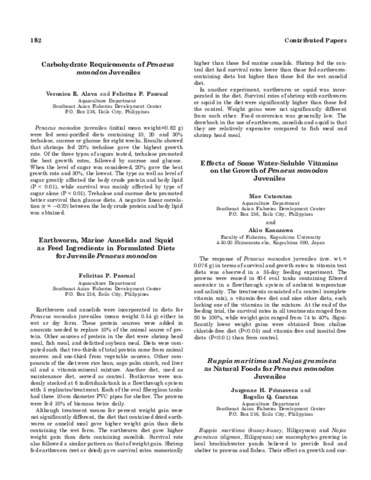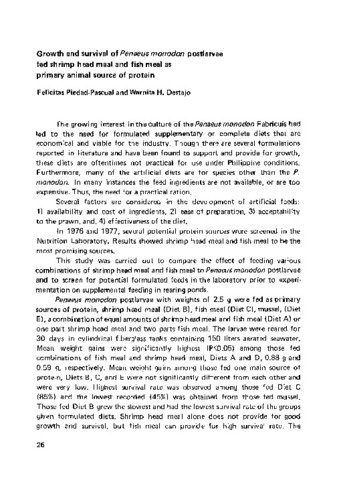Effect of dietary protein and energy level on growth, protein utilization and carcass composition of rabbitfish, Siganus guttatus
- Global styles
- MLA
- Vancouver
- Elsevier - Harvard
- APA
- Help

View/
Date
1990Author
Page views
2,766ASFA keyword
AGROVOC keyword
Metadata
Show full item record
Share
Abstract
Six semipurified diets comprising three levels of protein (25, 35, 45% of dry matter) each at two levels of estimated energy (3161, 3832 kcal/kg) were fed to fry for 8 weeks in 250-l tanks at a stocking density of 80 fish/tank. Growth increased with increasing dietary protein \((P\lt0.01)\) and energy \((P\lt0.05)\). Within isocaloric diets, a positive correlation was found between growth and dietary protein-to-energy \(\left(\frac{P}{E}\right)\) ratio \((P\lt0.05)\). Protein productive value (PPV) and protein efficiency ratio (PER) were negatively correlated with dietary \(\left(\frac{P}{E}\right)\) ratio. The equations describing this trend were: \(\mathsf{PPV}=50.16-0.19X\) and \(\mathsf{PER}=2.83-0.12X\), where \(X\) is \(\left(\frac{P}{E}\right)\). Based on responses for growth rate and efficiency of protein utilization, a diet with 35% protein and 3832 kcal/kg energy was found to be best for rabbitfish fry. Carcass fat levels increased in those fish fed diets with 3832 kcal/kg energy. Carcass protein and ash percentages remained essentially constant and independent of dietary treatment.
Suggested Citation
Parazo, M. M. (1990). Effect of dietary protein and energy level on growth, protein utilization and carcass composition of rabbitfish, Siganus guttatus. Aquaculture , 86(1), 41-49. https://doi.org/10.1016/0044-8486(90)90220-H
Type
ArticleISSN
0044-8486Collections
- Journal Articles [1258]
Related items
Showing items related by title, author, creator and subject.
-
Earthworm, marine annelids and squid as feed ingredients in formulated diets for juvenile Penaeus monodon
Pascual, F.P. (Aquaculture Department, Southeast Asian Fisheries Development Center, 1985)Earthworm and annelids were incorporated in diets for Penaeus monodon juveniles (mean weight 0.54 g) either in wet or dry form. These protein sources were added in amounts needed to replace 10% of the animal source of ... -
Growth and survival of Penaeus monodon postlarvae fed shrimp head meal and fish meal as primary animal source of protein
Piedad-Pascual, Felicitas; Destajo, Warnita H. (Aquaculture Department, Southeast Asian Fisheries Development Center, 1978)Although shrimp head meal alone does not provide for good growth and survival, fish meal can provide high survival rate. The addition of shrimp head improves this diet. It is suggested that cholesterol present in shrimp ... -
Series: ACIAR Monograph 110
Apparent digestibility of selected feed ingredients in diets for grouper (Epinephelus coioides) juveniles
Eusebio, Perla S.; Coloso, Relicardo M.; Mamauag, Roger Edward (Australian Centre for International Agricultural Research, 2004)
This study was conducted to determine the quality of selected feed ingredients as protein sources in grouper diets, based on their nutrient composition and apparent digestibility coefficients for dry matter (ADMD) and crude ...
(Australian Centre for International Agricultural Research, 2004)
This study was conducted to determine the quality of selected feed ingredients as protein sources in grouper diets, based on their nutrient composition and apparent digestibility coefficients for dry matter (ADMD) and crude ...




